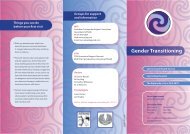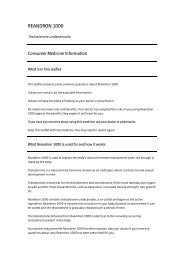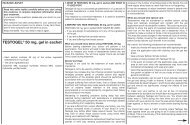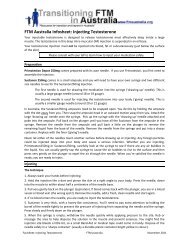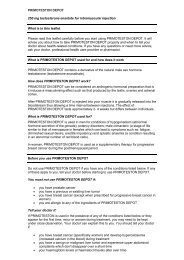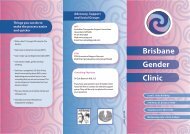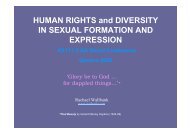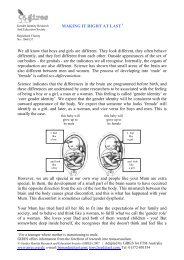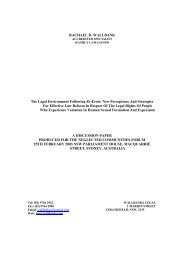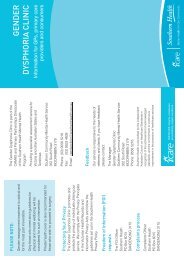It's My Body Isn't It - FTM Australia
It's My Body Isn't It - FTM Australia
It's My Body Isn't It - FTM Australia
You also want an ePaper? Increase the reach of your titles
YUMPU automatically turns print PDFs into web optimized ePapers that Google loves.
The resolution of this conflict occurs without the assistance of a statutory<br />
human rights framework. This is in contrast to virtually all other common<br />
law countries. Later in my presentation I will be comparing the position in<br />
<strong>Australia</strong> as pertaining to young people and medical treatment with that of<br />
the United Kingdom, which has had a Human Rights Act in force for ten<br />
years. <strong>My</strong> contention is that legislating to protect human rights in <strong>Australia</strong><br />
would see young people’s right to autonomy, privacy and self-determination<br />
emerge with far greater clarity in this very difficult area of the law.<br />
International human rights in <strong>Australia</strong>n law<br />
Although <strong>Australia</strong> does not have a Bill of Rights and the <strong>Australia</strong>n<br />
Constitution contains few express rights, that does not mean that human<br />
rights principles are alien to our municipal law. 3 We have ratified the<br />
International Covenant on Civil and Political Rights and the International<br />
Covenant on Economic, Social and Cultural Rights.<br />
Successive <strong>Australia</strong>n governments enacted specific legislation to give effect<br />
to its international obligations in the areas of racial discrimination, sex<br />
discrimination, disability discrimination and age discrimination. 4 The<br />
Human Rights and Equal Opportunity Commission (HREOC) administers<br />
these four Acts, as well as the Human Rights and Equal Opportunity Act<br />
1986 (Cth).<br />
A particularly important human rights instrument affecting children is the<br />
United Nations Convention on the Rights of the Child (UNCROC), the most<br />
ratified of all the international human rights treaties. The <strong>Australia</strong>n<br />
Government ratified UNCROC on 17 December 1990 and entered into force<br />
on 16 January 1991. To date however, no Government has passed<br />
legislation that seeks to give domestic effect to the rights of the child as<br />
embodied in the Convention.<br />
However, as the High Court confirmed in the decision Minister for<br />
Immigration and Ethnic Affairs v Teoh, the fact that UNCROC has not been<br />
incorporated into <strong>Australia</strong>n law does not mean that its ratification is of no<br />
significance. In their joint judgment, the (then) Chief Justice Mason and<br />
Justice Deane said: “Where a statute or subordinate legislation is<br />
3 Those rights include s 40, the right to vote, s 116, the right to freedom of religion, and s 117, the right to<br />
freedom from disabilities or discrimination on the basis of State residence. There is however a large body of<br />
jurisprudence on implied rights and freedoms in the <strong>Australia</strong>n Constitution, including <strong>Australia</strong>n Capital<br />
Television Pty Ltd v Commonwealth (1992) 177 CLR 106 on the implied right of political freedom and Chu<br />
Kheng Lim v Minister for Immigration, Local Government and Ethnic Affairs (1992) 176 CLR 1 on the right to<br />
due process under the law.<br />
4 Racial Discrimination Act 1975 (Cth), Sex Discrimination Act 1984 (Cth), Disability Discrimination Act 1992<br />
(Cth), Age Discrimination Act 2004 (Cth).<br />
4



